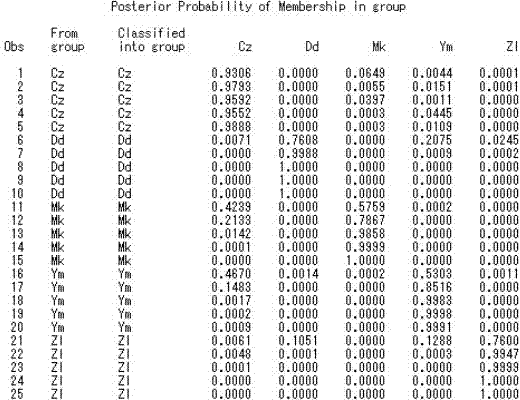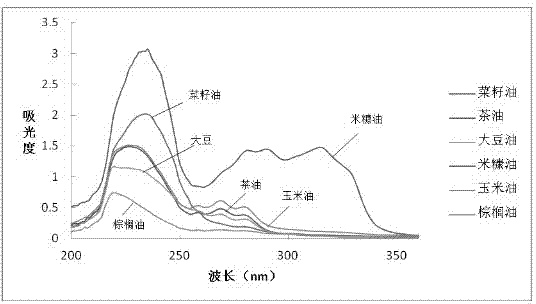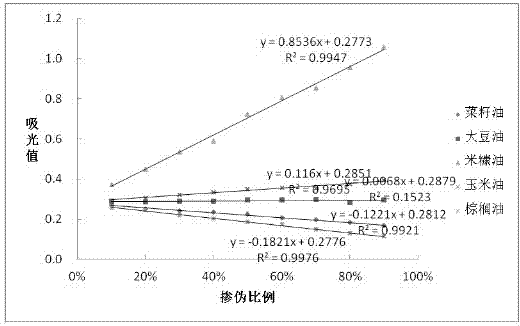Detection method for adulterated tea oil
A technology of camellia oil and species, applied in the field of camellia oil detection, achieves good linear relationship, is conducive to rapid detection, and has good repeatability.
- Summary
- Abstract
- Description
- Claims
- Application Information
AI Technical Summary
Problems solved by technology
Method used
Image
Examples
Embodiment 1
[0051] Embodiment 1 Determination and establishment of standard model
[0052] 1. Preparation of binary system mixed oil: mix tea oil with other vegetable oils in different proportions (volume ratio), mix
[0053] Concentrations are 10%, 20%, 30%, 40%, 50%, 60%, 70%, 80%, 90%, respectively.
[0054] 2. Identification of adulteration types of camellia oil adulteration:
[0055] 1) Select tea oil samples doped with different concentrations of soybean oil, rapeseed oil, corn oil, rice bran oil, and palm oil, and measure their refractive index, iodine value, and saponification value;
[0056] 2) Bayesian discriminant analysis was carried out by SAS software, that is, according to the refractive index, iodine value, saponification value and oleic acid content of the adulterated camellia oil samples with known doping types, they were divided into different populations according to the doping types; The refractive index, iodine value, saponification value and oleic ...
Embodiment 2
[0071] Embodiment 2: the mensuration of adulterated soybean oil in tea oil
[0072] 1. Identification of adulteration types of camellia oil adulteration:
[0073] 1) Collect tea oil samples mixed with different concentrations of soybean oil, rapeseed oil, corn oil, rice bran oil and palm oil, and measure their refractive index, iodine value, saponification value and oleic acid content;
[0074] 2) Bayesian discriminant analysis was carried out by SAS software, that is, according to the refractive index, iodine value, saponification value and oleic acid content of the adulterated camellia oil samples with known doping types, they were divided into different populations according to the doping types; The refractive index, iodine value, saponification value and oleic acid content of unknown samples are analyzed to analyze the probability of belonging to different populations. This probability is used as a criterion for discrimination and classification, so as to reali...
Embodiment 3
[0086] Embodiment 3: the mensuration of doped rapeseed oil in tea oil
[0087] 1. Identification of adulteration types of camellia oil adulteration:
[0088] 1) Collect tea oil samples mixed with different concentrations of soybean oil, rapeseed oil, corn oil, rice bran oil and palm oil, and measure their refractive index, iodine value, saponification value and oleic acid content;
[0089] 2) Bayesian discriminant analysis was carried out by SAS software, that is, according to the refractive index, iodine value, saponification value and oleic acid content of the adulterated camellia oil samples with known doping types, they were divided into different populations according to the doping types; The refractive index, iodine value, saponification value and oleic acid content of unknown samples are analyzed to analyze the probability of belonging to different populations. This probability is used as a criterion for discrimination and classification, so as to realize the id...
PUM
| Property | Measurement | Unit |
|---|---|---|
| concentration | aaaaa | aaaaa |
Abstract
Description
Claims
Application Information
 Login to View More
Login to View More - R&D
- Intellectual Property
- Life Sciences
- Materials
- Tech Scout
- Unparalleled Data Quality
- Higher Quality Content
- 60% Fewer Hallucinations
Browse by: Latest US Patents, China's latest patents, Technical Efficacy Thesaurus, Application Domain, Technology Topic, Popular Technical Reports.
© 2025 PatSnap. All rights reserved.Legal|Privacy policy|Modern Slavery Act Transparency Statement|Sitemap|About US| Contact US: help@patsnap.com



